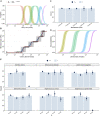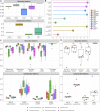Equivolumetric Protocol Generates Library Sizes Proportional to Total Microbial Load in 16S Amplicon Sequencing
- PMID: 33717032
- PMCID: PMC7952455
- DOI: 10.3389/fmicb.2021.638231
Equivolumetric Protocol Generates Library Sizes Proportional to Total Microbial Load in 16S Amplicon Sequencing
Abstract
High-throughput sequencing of 16S rRNA amplicon has been extensively employed to perform microbiome characterization worldwide. As a culture-independent methodology, it has allowed high-level profiling of sample bacterial composition directly from samples. However, most studies are limited to information regarding relative bacterial abundances (sample proportions), ignoring scenarios in which sample microbe biomass can vary widely. Here, we use an equivolumetric protocol for 16S rRNA amplicon library preparation capable of generating Illumina sequencing data responsive to input DNA, recovering proportionality between observed read counts and absolute bacterial abundances within each sample. Under specified conditions, we show that the estimation of colony-forming units (CFU), the most common unit of bacterial abundance in classical microbiology, is challenged mostly by resolution and taxon-to-taxon variation. We propose Bayesian cumulative probability models to address such issues. Our results indicate that predictive errors vary consistently below one order of magnitude for total microbial load and abundance of observed bacteria. We also demonstrate our approach has the potential to generalize to previously unseen bacteria, but predictive performance is hampered by specific taxa of uncommon profile. Finally, it remains clear that high-throughput sequencing data are not inherently restricted to sample proportions only, and such technologies bear the potential to meet the working scales of traditional microbiology.
Keywords: 16S rRNA; Illumina; absolute abundances; amplicon sequencing; bacteria; colony-forming units; microbiome.
Copyright © 2021 Cruz, Christoff and de Oliveira.
Conflict of interest statement
All authors are currently full-time employees of BiomeHub (SC, Brazil), a research and consulting company specialized in microbiome technologies. BiomeHub funded the study design, analysis, and data submission for publication.
Figures





Similar articles
-
Complementing 16S rRNA Gene Amplicon Sequencing with Total Bacterial Load To Infer Absolute Species Concentrations in the Vaginal Microbiome.mSystems. 2020 Apr 7;5(2):e00777-19. doi: 10.1128/mSystems.00777-19. mSystems. 2020. PMID: 32265316 Free PMC article.
-
Improved DNA Extraction and Amplification Strategy for 16S rRNA Gene Amplicon-Based Microbiome Studies.Int J Mol Sci. 2024 Mar 4;25(5):2966. doi: 10.3390/ijms25052966. Int J Mol Sci. 2024. PMID: 38474213 Free PMC article.
-
A novel ultra high-throughput 16S rRNA gene amplicon sequencing library preparation method for the Illumina HiSeq platform.Microbiome. 2017 Jul 6;5(1):68. doi: 10.1186/s40168-017-0279-1. Microbiome. 2017. PMID: 28683838 Free PMC article.
-
Towards Quantitative Microbiome Community Profiling Using Internal Standards.Appl Environ Microbiol. 2019 Feb 20;85(5):e02634-18. doi: 10.1128/AEM.02634-18. Print 2019 Mar 1. Appl Environ Microbiol. 2019. PMID: 30552195 Free PMC article.
-
PCR-based quantification of taxa-specific abundances in microbial communities: Quantifying and avoiding common pitfalls.J Microbiol Methods. 2018 Oct;153:139-147. doi: 10.1016/j.mimet.2018.09.015. Epub 2018 Sep 26. J Microbiol Methods. 2018. PMID: 30267718 Review.
Cited by
-
Sampling the fish gill microbiome: a comparison of tissue biopsies and swabs.BMC Microbiol. 2021 Nov 10;21(1):313. doi: 10.1186/s12866-021-02374-0. BMC Microbiol. 2021. PMID: 34758745 Free PMC article.
-
Host biology, ecology and the environment influence microbial biomass and diversity in 101 marine fish species.Nat Commun. 2022 Nov 17;13(1):6978. doi: 10.1038/s41467-022-34557-2. Nat Commun. 2022. PMID: 36396943 Free PMC article.
-
Microbial context predicts SARS-CoV-2 prevalence in patients and the hospital built environment.medRxiv [Preprint]. 2020 Nov 22:2020.11.19.20234229. doi: 10.1101/2020.11.19.20234229. medRxiv. 2020. Update in: Microbiome. 2021 Jun 8;9(1):132. doi: 10.1186/s40168-021-01083-0. PMID: 33236030 Free PMC article. Updated. Preprint.
-
In vivo assessment of the effect of gel containing lactic acid and glycogen on vaginal microbiota and pH of asymptomatic women of reproductive age.PLoS One. 2025 Apr 24;20(4):e0321737. doi: 10.1371/journal.pone.0321737. eCollection 2025. PLoS One. 2025. PMID: 40273081 Free PMC article.
-
Organosilane for surface cleaning in intensive care units: protocol for a cluster randomized controlled trial with crossover.Crit Care Sci. 2025 Jul 11;37:e20250319. doi: 10.62675/2965-2774.20250319. eCollection 2025. Crit Care Sci. 2025. PMID: 40667968 Free PMC article.
References
-
- Agresti A. (2010a). Wiley Series in Probability and Statistics. Hoboken, NJ: John Wiley & Sons, Inc, 281–314. 10.1002/9780470594001.ch10 - DOI
-
- Agresti A. (2010b). Wiley Series in Probability and Statistics. Hoboken, NJ: John Wiley & Sons, Inc, 44–87. 10.1002/9780470594001.ch3 - DOI
-
- Bürkner P. (2017). brms?: an R Package for bayesian multilevel models using stan. J. Stat. Softw. 80:29856. 10.18637/jss.v080.i01 - DOI
LinkOut - more resources
Full Text Sources
Other Literature Sources
Molecular Biology Databases
Research Materials

